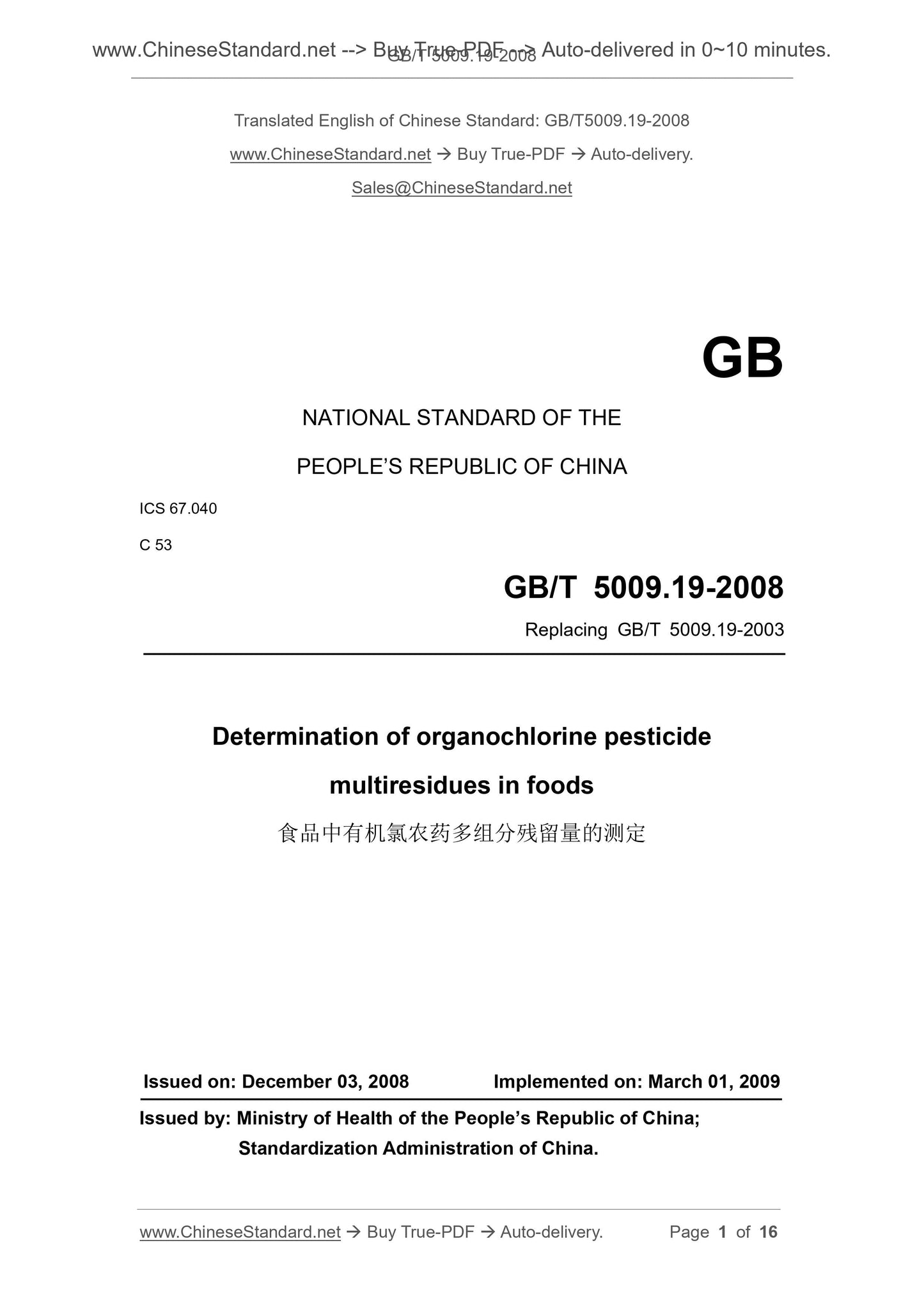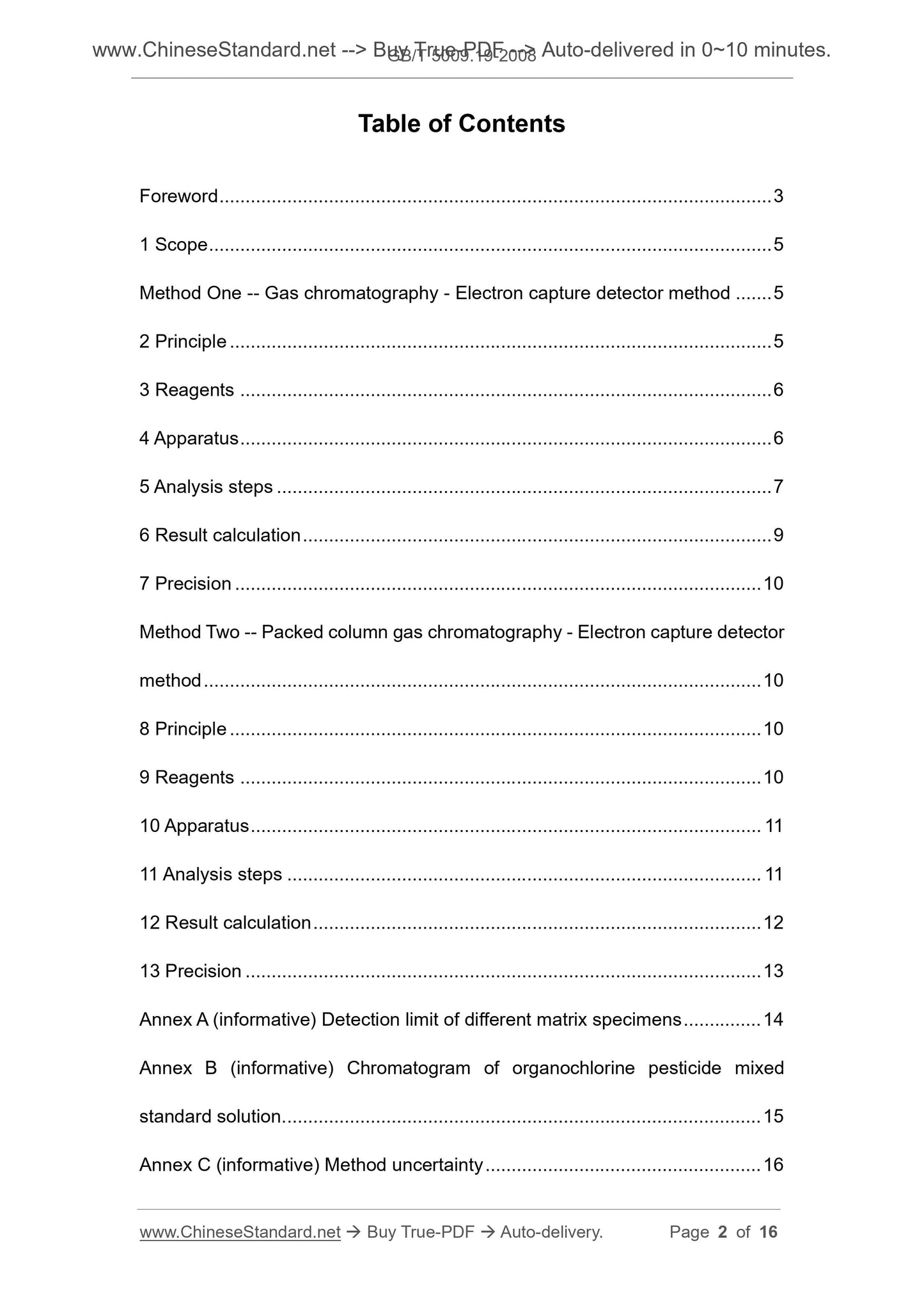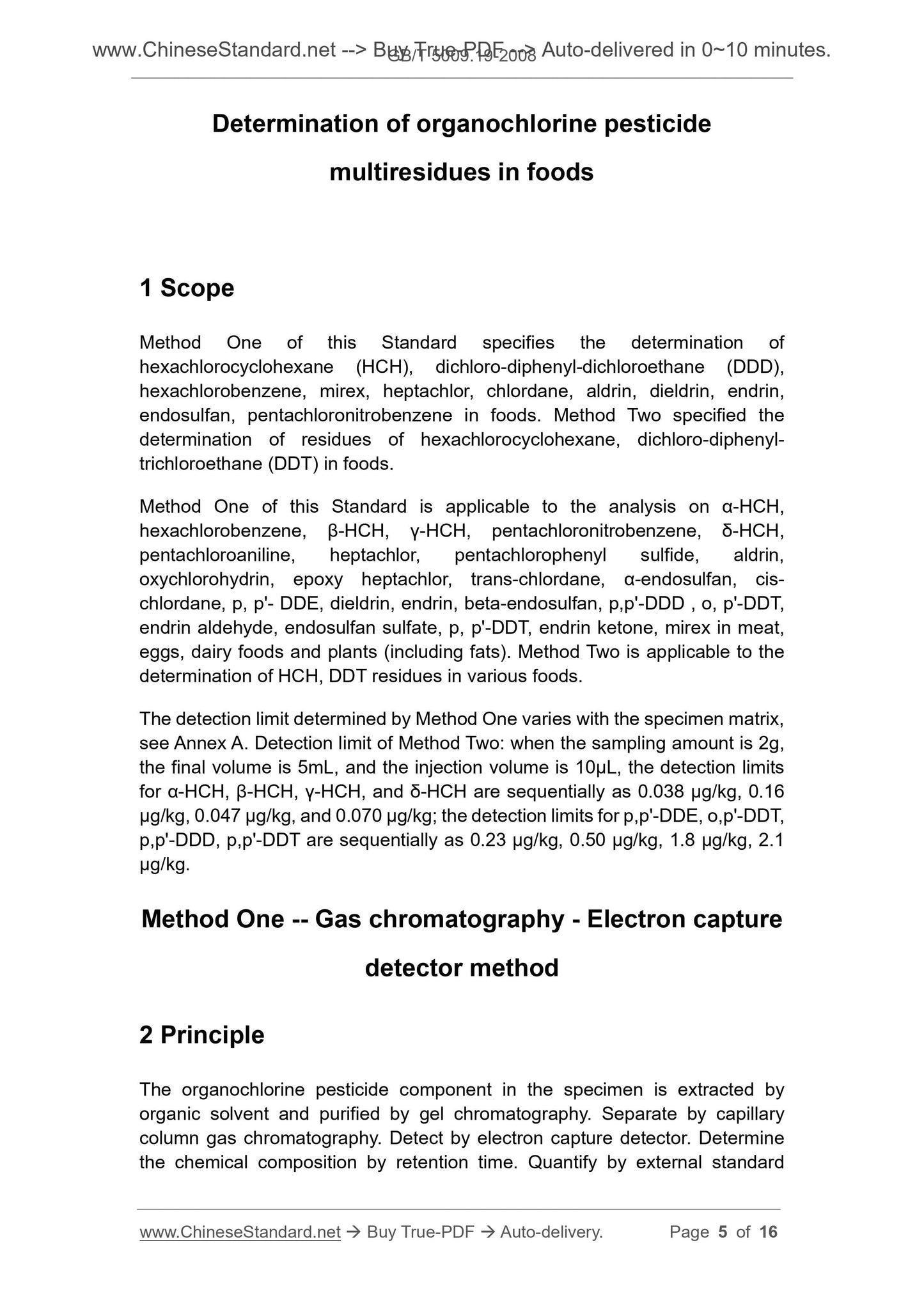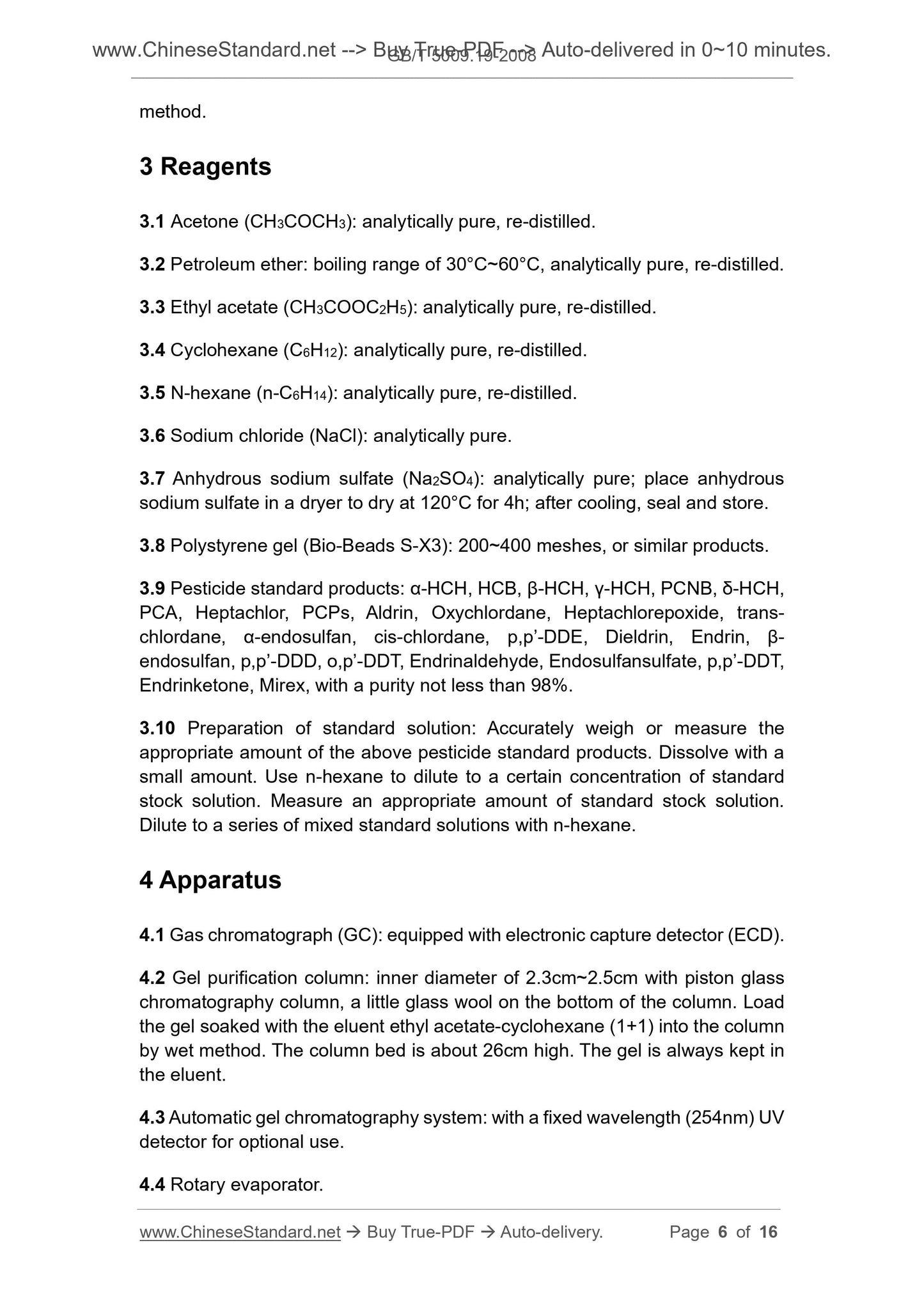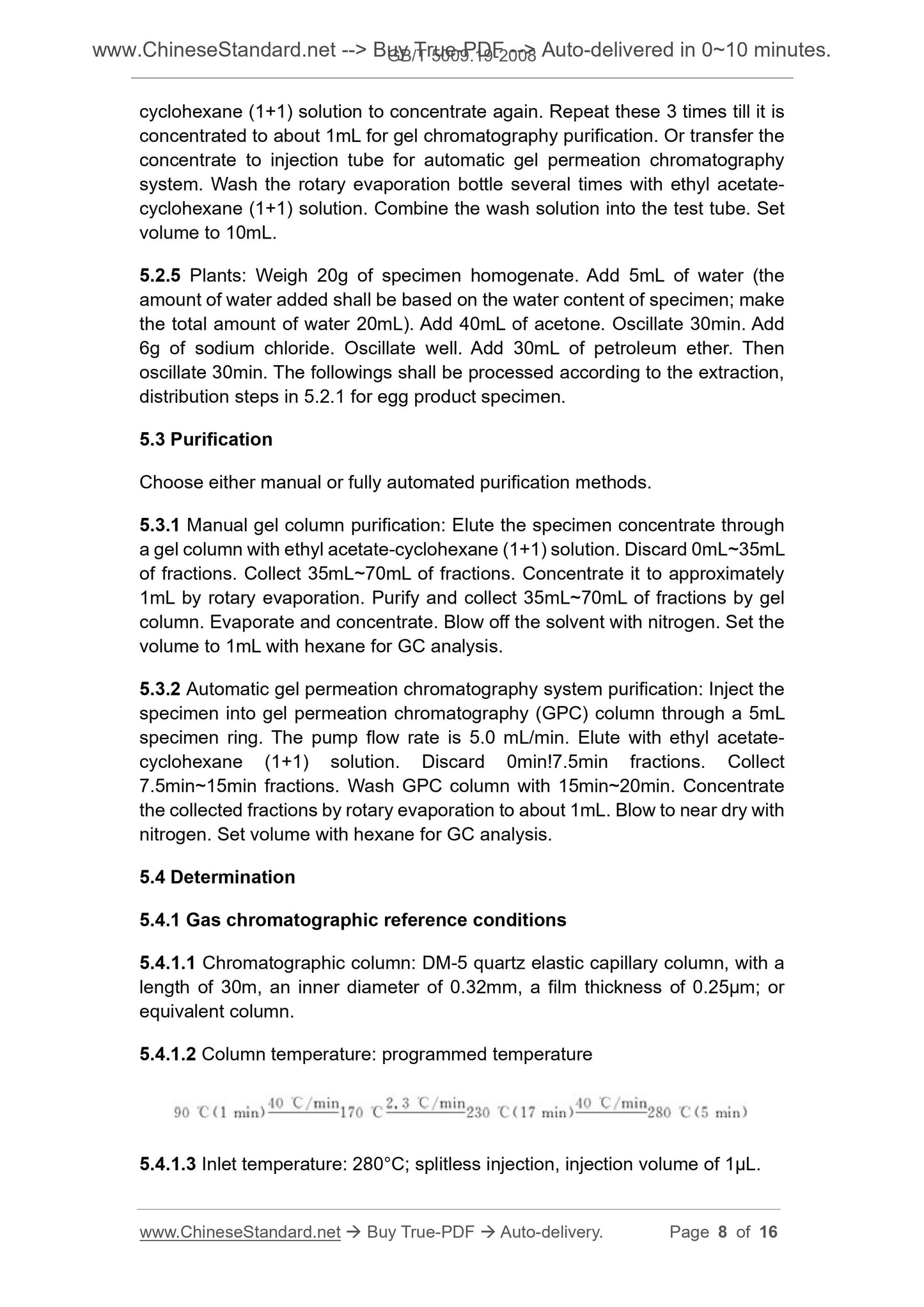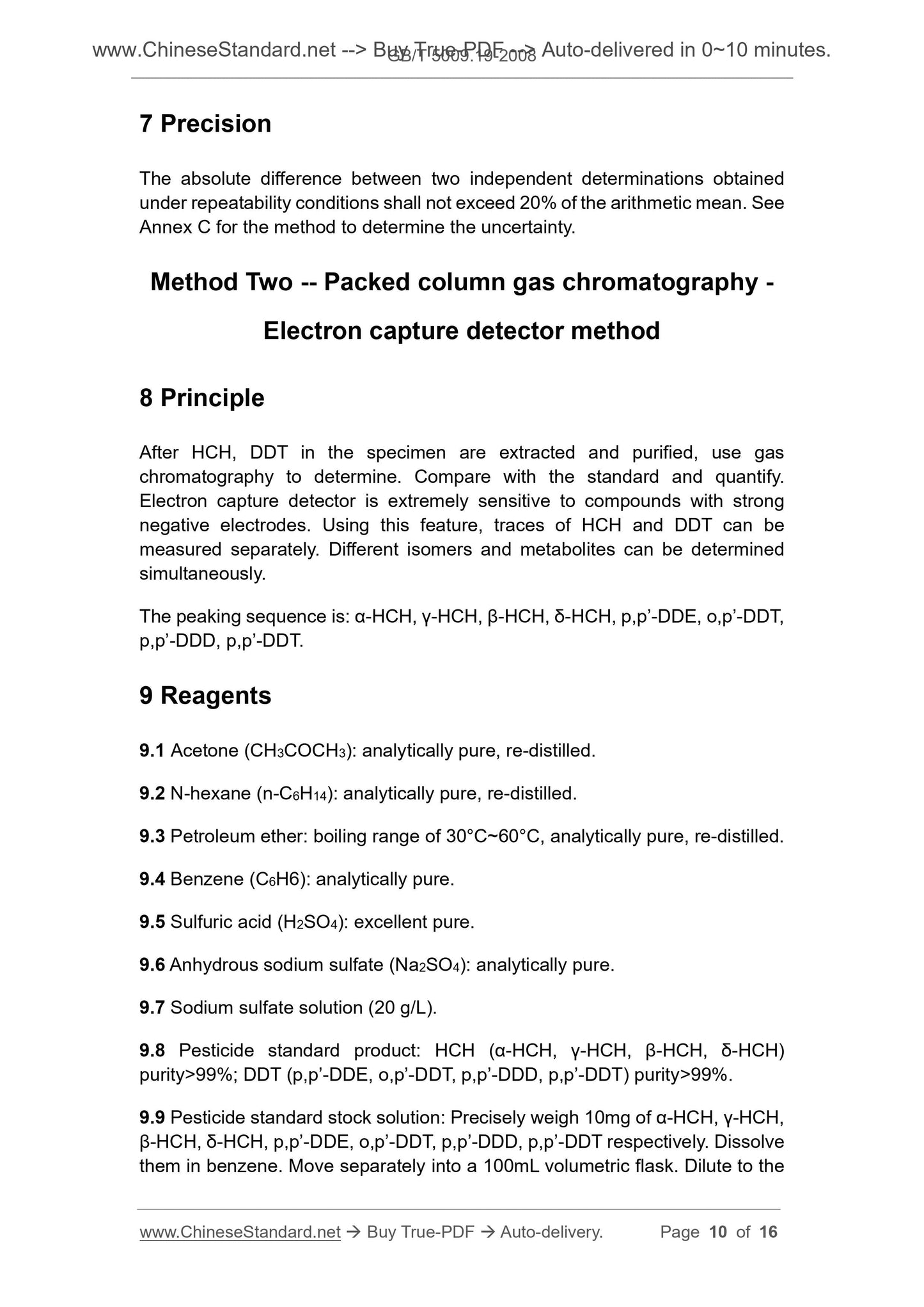1
/
of
6
PayPal, credit cards. Download editable-PDF and invoice in 1 second!
GB/T 5009.19-2008 English PDF (GBT5009.19-2008)
GB/T 5009.19-2008 English PDF (GBT5009.19-2008)
Regular price
$85.00 USD
Regular price
Sale price
$85.00 USD
Unit price
/
per
Shipping calculated at checkout.
Couldn't load pickup availability
Delivery: 3 seconds. Download true-PDF + Invoice.
Get QUOTATION in 1-minute: Click GB/T 5009.19-2008
Historical versions: GB/T 5009.19-2008
Preview True-PDF (Reload/Scroll if blank)
GB/T 5009.19-2008: Determination of organochlorine pesticide multiresidues in foods
NATIONAL STANDARD OF THE
PEOPLE’S REPUBLIC OF CHINA
ICS 67.040 C 53
GB/T 5009.19-2008
Replacing GB/T 5009.19-2003
Determination of organochlorine pesticide multiresidues in foods
Issued on. December 03, 2008 Implemented on. March 01, 2009 Issued by. Ministry of Health of the People’s Republic of China; Standardization Administration of China.
Table of Contents
Foreword ... 3
1 Scope ... 5
Method One -- Gas chromatography - Electron capture detector method ... 5
2 Principle ... 5
3 Reagents ... 6
4 Apparatus ... 6
5 Analysis steps ... 7
6 Result calculation ... 9
7 Precision ... 10
Method Two -- Packed column gas chromatography -Electron capture detector
method ... 10
8 Principle ... 10
9 Reagents ... 10
10 Apparatus ... 11
11 Analysis steps ... 11
12 Result calculation ... 12
13 Precision ... 13
Annex A (informative) Detection limit of different matrix specimens ... 14
Annex B (informative) Chromatogram of organochlorine pesticide mixed
standard solution ... 15
Annex C (informative) Method uncertainty ... 16
Determination of organochlorine pesticide
multiresidues in foods
1 Scope
Method One of this Standard specifies the determination of hexachlorocyclohexane (HCH), dichloro-diphenyl-dichloroethane (DDD), hexachlorobenzene, mirex, heptachlor, chlordane, aldrin, dieldrin, endrin, endosulfan, pentachloronitrobenzene in foods. Method Two specified the determination of residues of hexachlorocyclohexane, dichloro-diphenyltrichloroethane (DDT) in foods.
Method One of this Standard is applicable to the analysis on α-HCH, hexachlorobenzene, β-HCH, γ-HCH, pentachloronitrobenzene, δ-HCH, pentachloroaniline, heptachlor, pentachlorophenyl sulfide, aldrin, oxychlorohydrin, epoxy heptachlor, trans-chlordane, α-endosulfan, cischlordane, p, p'- DDE, dieldrin, endrin, beta-endosulfan, p,p'-DDD , o, p'-DDT, endrin aldehyde, endosulfan sulfate, p, p'-DDT, endrin ketone, mirex in meat, eggs, dairy foods and plants (including fats). Method Two is applicable to the determination of HCH, DDT residues in various foods.
The detection limit determined by Method One varies with the specimen matrix, see Annex A. Detection limit of Method Two. when the sampling amount is 2g, the final volume is 5mL, and the injection volume is 10μL, the detection limits for α-HCH, β-HCH, γ-HCH, and δ-HCH are sequentially as 0.038 μg/kg, 0.16 μg/kg, 0.047 μg/kg, and 0.070 μg/kg; the detection limits for p,p'-DDE, o,p'-DDT, p,p'-DDD, p,p'-DDT are sequentially as 0.23 μg/kg, 0.50 μg/kg, 1.8 μg/kg, 2.1 μg/kg.
Method One -- Gas chromatography - Electron capture
detector method
2 Principle
The organochlorine pesticide component in the specimen is extracted by organic solvent and purified by gel chromatography. Separate by capillary column gas chromatography. Detect by electron capture detector. Determine the chemical composition by retention time. Quantify by external standard method.
3 Reagents
3.1 Acetone (CH3COCH3). analytically pure, re-distilled.
3.2 Petroleum ether. boiling range of 30°C~60°C, analytically pure, re-distilled.
3.3 Ethyl acetate (CH3COOC2H5). analytically pure, re-distilled.
3.4 Cyclohexane (C6H12). analytically pure, re-distilled.
3.5 N-hexane (n-C6H14). analytically pure, re-distilled.
3.6 Sodium chloride (NaCl). analytically pure.
3.7 Anhydrous sodium sulfate (Na2SO4). analytically pure; place anhydrous sodium sulfate in a dryer to dry at 120°C for 4h; after cooling, seal and store.
3.8 Polystyrene gel (Bio-Beads S-X3). 200~400 meshes, or similar products.
3.9 Pesticide standard products. α-HCH, HCB, β-HCH, γ-HCH, PCNB, δ-HCH, PCA, Heptachlor, PCPs, Aldrin, Oxychlordane, Heptachlorepoxide, trans-chlordane, α-endosulfan, cis-chlordane, p,p’-DDE, Dieldrin, Endrin, βendosulfan, p,p’-DDD, o,p’-DDT, Endrinaldehyde, Endosulfansulfate, p,p’-DDT, Endrinketone, Mirex, with a purity not less than 98%.
3.10
Preparation of standard solution. Accurately weigh or measure the appropriate amount of the above pesticide standard products. Dissolve with a small amount. Use n-hexane to dilute to a certain concentration of standard stock solution. Measure an appropriate amount of standard stock solution. Dilute to a series of mixed standard solutions with n-hexane.
4 Apparatus
4.1
Gas chromatograph (GC). equipped with electronic capture detector (ECD).
4.2 Gel purification column. inner diameter of 2.3cm~2.5cm with piston glass chromatography column, a little glass wool on the bottom of the column. Load the gel soaked with the eluent ethyl acetate-cyclohexane (1+1) into the column by wet method. The column bed is about 26cm high. The gel is always kept in the eluent.
4.3 Automatic gel chromatography system. with a fixed wavelength (254nm) UV detector for optional use.
4.4 Rotary evaporator.
cyclohexane (1+1) solution to concentrate again. Repeat these 3 times till it is concentrated to about 1mL for gel chromatography purification. Or transfer the concentrate to injection tube for automatic gel permeation chromatography system. Wash the rotary evaporation bottle several times with ethyl acetatecyclohexane (1+1) solution. Combine the wash solution into the test tube. Set volume to 10mL.
5.2.5 Plants. Weigh 20g of specimen homogenate. Add 5mL of water (the amount of water added shall be based on the water content of specimen; make the total amount of water 20mL). Add 40mL of acetone. Oscillate 30min. Add 6g of sodium chloride. Oscillate well. Add 30mL of petroleum ether. Then oscillate 30min. The followings shall be processed according to the extraction, distribution steps in 5.2.1 for egg product specimen.
5.3 Purification
Choose either manual or fully automated purification methods.
5.3.1 Manual gel column purification. Elute the specimen concentrate through a gel column with ethyl acetate-cyclohexane (1+1) solution. Discard 0mL~35mL of fractions. Collect 35mL~70mL of fractions. Concentrate it to approximately 1mL by rotary evaporation. Purify and collect 35mL~70mL of fractions by gel column. Evaporate and concentrate. Blow off the solvent with nitrogen. Set the volume to 1mL with hexane for GC analysis.
5.3.2 Automatic gel permeation chromatography system purification. Inject the specimen into gel permeation chromatography (GPC) column through a 5mL specimen ring. The pump flow rate is 5.0 mL/min. Elute with ethyl acetatecyclohexane (1+1) solution. Discard 0min!7.5min fractions. Collect 7.5min~15min fractions. Wash GPC column with 15min~20min. Concentrate the collected fractions by rotary evaporation to about 1mL. Blow to near dry with nitrogen. Set volume with hexane for GC analysis.
5.4 Determination
5.4.1 Gas chromatographic reference conditions
5.4.1.1 Chromatographic column. DM-5 quartz elastic capillary column, with a length of 30m, an inner diameter of 0.32mm, a film thickness of 0.25μm; or equivalent column.
5.4.1.2 Column temperature. programmed temperature
5.4.1.3 Inlet temperature. 280°C; splitless injection, injection volume of 1μL.
7 Precision
The absolute difference between two independent determinations obtained under repeatability conditions shall not exceed 20% of the arithmetic mean. See Annex C for the method to determine the uncertainty.
Method Two -- Packed column gas chromatography -
Electron capture detector method
8 Principle
After HCH, DDT in the specimen are extracted and purified, use gas chromatography to determine. Compare with the standard and quantify. Electron capture detector is extremely sensitive to compounds with strong negative electrodes. Using this feature, traces of HCH and DDT can be measured separately. Different isomers and metabolites can be determined simultaneously.
The peaking sequence ...
Get QUOTATION in 1-minute: Click GB/T 5009.19-2008
Historical versions: GB/T 5009.19-2008
Preview True-PDF (Reload/Scroll if blank)
GB/T 5009.19-2008: Determination of organochlorine pesticide multiresidues in foods
NATIONAL STANDARD OF THE
PEOPLE’S REPUBLIC OF CHINA
ICS 67.040 C 53
GB/T 5009.19-2008
Replacing GB/T 5009.19-2003
Determination of organochlorine pesticide multiresidues in foods
Issued on. December 03, 2008 Implemented on. March 01, 2009 Issued by. Ministry of Health of the People’s Republic of China; Standardization Administration of China.
Table of Contents
Foreword ... 3
1 Scope ... 5
Method One -- Gas chromatography - Electron capture detector method ... 5
2 Principle ... 5
3 Reagents ... 6
4 Apparatus ... 6
5 Analysis steps ... 7
6 Result calculation ... 9
7 Precision ... 10
Method Two -- Packed column gas chromatography -Electron capture detector
method ... 10
8 Principle ... 10
9 Reagents ... 10
10 Apparatus ... 11
11 Analysis steps ... 11
12 Result calculation ... 12
13 Precision ... 13
Annex A (informative) Detection limit of different matrix specimens ... 14
Annex B (informative) Chromatogram of organochlorine pesticide mixed
standard solution ... 15
Annex C (informative) Method uncertainty ... 16
Determination of organochlorine pesticide
multiresidues in foods
1 Scope
Method One of this Standard specifies the determination of hexachlorocyclohexane (HCH), dichloro-diphenyl-dichloroethane (DDD), hexachlorobenzene, mirex, heptachlor, chlordane, aldrin, dieldrin, endrin, endosulfan, pentachloronitrobenzene in foods. Method Two specified the determination of residues of hexachlorocyclohexane, dichloro-diphenyltrichloroethane (DDT) in foods.
Method One of this Standard is applicable to the analysis on α-HCH, hexachlorobenzene, β-HCH, γ-HCH, pentachloronitrobenzene, δ-HCH, pentachloroaniline, heptachlor, pentachlorophenyl sulfide, aldrin, oxychlorohydrin, epoxy heptachlor, trans-chlordane, α-endosulfan, cischlordane, p, p'- DDE, dieldrin, endrin, beta-endosulfan, p,p'-DDD , o, p'-DDT, endrin aldehyde, endosulfan sulfate, p, p'-DDT, endrin ketone, mirex in meat, eggs, dairy foods and plants (including fats). Method Two is applicable to the determination of HCH, DDT residues in various foods.
The detection limit determined by Method One varies with the specimen matrix, see Annex A. Detection limit of Method Two. when the sampling amount is 2g, the final volume is 5mL, and the injection volume is 10μL, the detection limits for α-HCH, β-HCH, γ-HCH, and δ-HCH are sequentially as 0.038 μg/kg, 0.16 μg/kg, 0.047 μg/kg, and 0.070 μg/kg; the detection limits for p,p'-DDE, o,p'-DDT, p,p'-DDD, p,p'-DDT are sequentially as 0.23 μg/kg, 0.50 μg/kg, 1.8 μg/kg, 2.1 μg/kg.
Method One -- Gas chromatography - Electron capture
detector method
2 Principle
The organochlorine pesticide component in the specimen is extracted by organic solvent and purified by gel chromatography. Separate by capillary column gas chromatography. Detect by electron capture detector. Determine the chemical composition by retention time. Quantify by external standard method.
3 Reagents
3.1 Acetone (CH3COCH3). analytically pure, re-distilled.
3.2 Petroleum ether. boiling range of 30°C~60°C, analytically pure, re-distilled.
3.3 Ethyl acetate (CH3COOC2H5). analytically pure, re-distilled.
3.4 Cyclohexane (C6H12). analytically pure, re-distilled.
3.5 N-hexane (n-C6H14). analytically pure, re-distilled.
3.6 Sodium chloride (NaCl). analytically pure.
3.7 Anhydrous sodium sulfate (Na2SO4). analytically pure; place anhydrous sodium sulfate in a dryer to dry at 120°C for 4h; after cooling, seal and store.
3.8 Polystyrene gel (Bio-Beads S-X3). 200~400 meshes, or similar products.
3.9 Pesticide standard products. α-HCH, HCB, β-HCH, γ-HCH, PCNB, δ-HCH, PCA, Heptachlor, PCPs, Aldrin, Oxychlordane, Heptachlorepoxide, trans-chlordane, α-endosulfan, cis-chlordane, p,p’-DDE, Dieldrin, Endrin, βendosulfan, p,p’-DDD, o,p’-DDT, Endrinaldehyde, Endosulfansulfate, p,p’-DDT, Endrinketone, Mirex, with a purity not less than 98%.
3.10
Preparation of standard solution. Accurately weigh or measure the appropriate amount of the above pesticide standard products. Dissolve with a small amount. Use n-hexane to dilute to a certain concentration of standard stock solution. Measure an appropriate amount of standard stock solution. Dilute to a series of mixed standard solutions with n-hexane.
4 Apparatus
4.1
Gas chromatograph (GC). equipped with electronic capture detector (ECD).
4.2 Gel purification column. inner diameter of 2.3cm~2.5cm with piston glass chromatography column, a little glass wool on the bottom of the column. Load the gel soaked with the eluent ethyl acetate-cyclohexane (1+1) into the column by wet method. The column bed is about 26cm high. The gel is always kept in the eluent.
4.3 Automatic gel chromatography system. with a fixed wavelength (254nm) UV detector for optional use.
4.4 Rotary evaporator.
cyclohexane (1+1) solution to concentrate again. Repeat these 3 times till it is concentrated to about 1mL for gel chromatography purification. Or transfer the concentrate to injection tube for automatic gel permeation chromatography system. Wash the rotary evaporation bottle several times with ethyl acetatecyclohexane (1+1) solution. Combine the wash solution into the test tube. Set volume to 10mL.
5.2.5 Plants. Weigh 20g of specimen homogenate. Add 5mL of water (the amount of water added shall be based on the water content of specimen; make the total amount of water 20mL). Add 40mL of acetone. Oscillate 30min. Add 6g of sodium chloride. Oscillate well. Add 30mL of petroleum ether. Then oscillate 30min. The followings shall be processed according to the extraction, distribution steps in 5.2.1 for egg product specimen.
5.3 Purification
Choose either manual or fully automated purification methods.
5.3.1 Manual gel column purification. Elute the specimen concentrate through a gel column with ethyl acetate-cyclohexane (1+1) solution. Discard 0mL~35mL of fractions. Collect 35mL~70mL of fractions. Concentrate it to approximately 1mL by rotary evaporation. Purify and collect 35mL~70mL of fractions by gel column. Evaporate and concentrate. Blow off the solvent with nitrogen. Set the volume to 1mL with hexane for GC analysis.
5.3.2 Automatic gel permeation chromatography system purification. Inject the specimen into gel permeation chromatography (GPC) column through a 5mL specimen ring. The pump flow rate is 5.0 mL/min. Elute with ethyl acetatecyclohexane (1+1) solution. Discard 0min!7.5min fractions. Collect 7.5min~15min fractions. Wash GPC column with 15min~20min. Concentrate the collected fractions by rotary evaporation to about 1mL. Blow to near dry with nitrogen. Set volume with hexane for GC analysis.
5.4 Determination
5.4.1 Gas chromatographic reference conditions
5.4.1.1 Chromatographic column. DM-5 quartz elastic capillary column, with a length of 30m, an inner diameter of 0.32mm, a film thickness of 0.25μm; or equivalent column.
5.4.1.2 Column temperature. programmed temperature
5.4.1.3 Inlet temperature. 280°C; splitless injection, injection volume of 1μL.
7 Precision
The absolute difference between two independent determinations obtained under repeatability conditions shall not exceed 20% of the arithmetic mean. See Annex C for the method to determine the uncertainty.
Method Two -- Packed column gas chromatography -
Electron capture detector method
8 Principle
After HCH, DDT in the specimen are extracted and purified, use gas chromatography to determine. Compare with the standard and quantify. Electron capture detector is extremely sensitive to compounds with strong negative electrodes. Using this feature, traces of HCH and DDT can be measured separately. Different isomers and metabolites can be determined simultaneously.
The peaking sequence ...
Share
